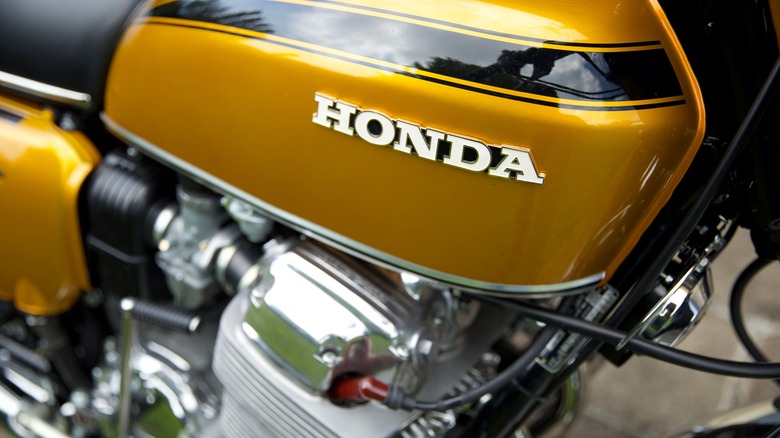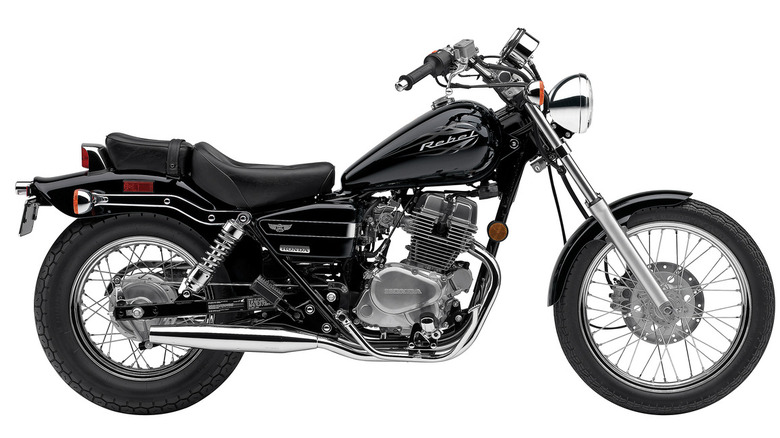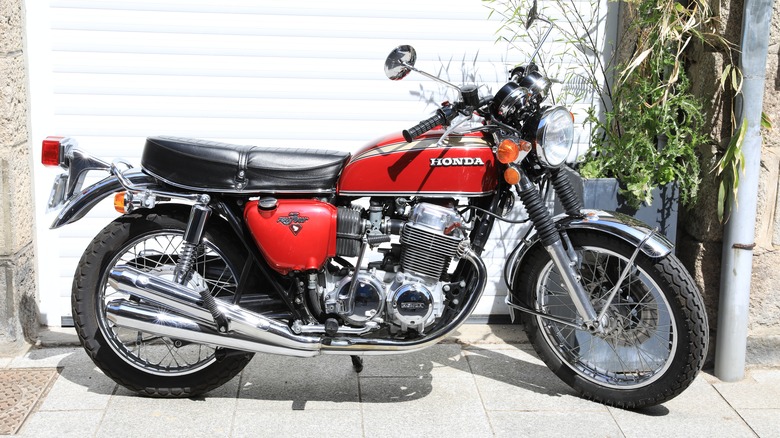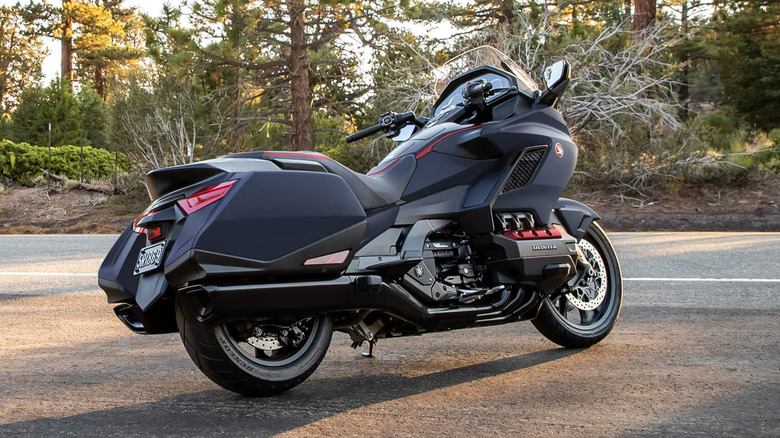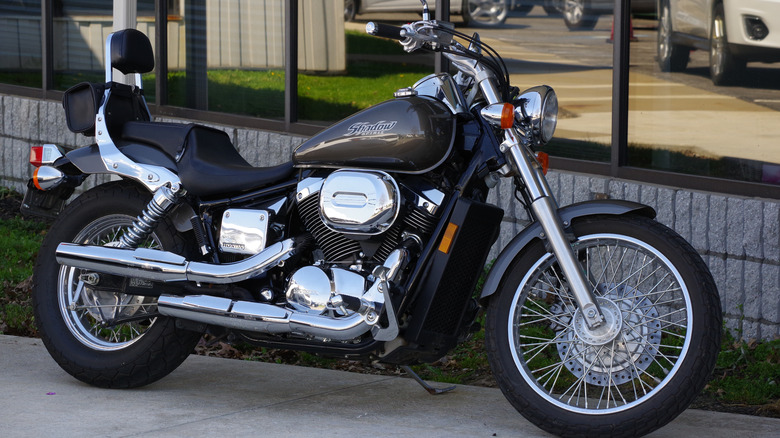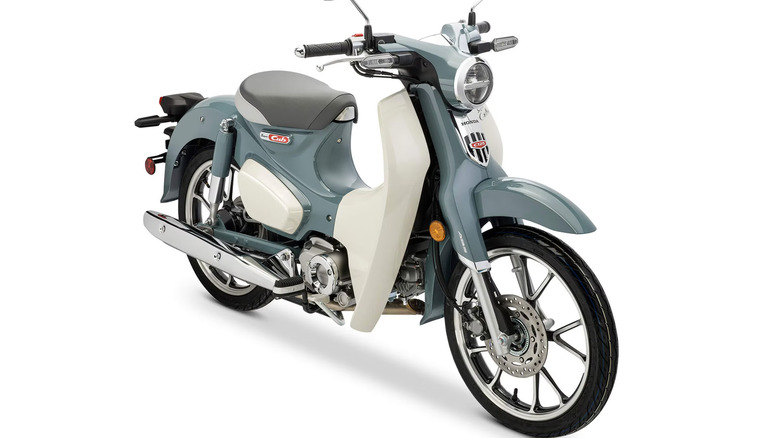5 Of The Most Reliable Honda Motorcycles You Can Buy
When you think of Honda, one of the first things that springs to mind is the brand's well-deserved reputation for reliability, but before Honda started churning out popular cars like the Accord and CR-V, it exclusively manufactured motorcycles. A lot of motorcycles. Beginning production in the late 1940s, the brand rapidly climbed to the position of the largest motorcycle producer in Japan and by 2014, more than three hundred million bikes were sold worldwide.
Of course, not every design was a winner. In the early 1980s, the reputation of Honda's new VF750F Interceptor sport bike was soiled by a V4 engine with a reputation for eating camshafts, but such instances are definitely the exception, not the rule. With regular routine maintenance, most Hondas will reward their owners with years of trouble-free service. From bikes for the beginning rider to boulevard cruisers to long-distance tourers, here are some of the new and vintage Hondas that will make you a believer in Honda's legendary durability.
1985 - 2016: Honda Rebel 250
Honda's little Rebel has long been one of the top choices for newer riders, as well as those of smaller stature. Its low seat height makes it easy for its pilot to touch the ground, the controls are simple, and it's highly maneuverable. Those characteristics make it a staple of Motorcycle Safety Foundation training classes across the nation.
The "250" refers to the bike's 234 cubic centimeter (cc) two-cylinder engine — rounded up to 250cc for naming purposes — which is just about as simple as it gets. Air-cooling means you can ditch the maintenance or repair regimen of liquid cooling and the decades-old design, while not cutting edge, is considered bulletproof by those in the know.
The Rebel 250 has a single disc brake up front and a simple drum braking system in the rear. Not much for frills, the only gauge is a speedometer so you'll have to shift by engine sound. In 2017, the beginner bike was completely redesigned as the Rebel 300, but it can't match the unabashed simplicity and classic styling of the original.
1969 - 2003: Honda CB750
In 1969, Honda truly set itself apart from the pack with its CB750, one of the best bikes the brand ever made and one that would come to define the modern-era Universal Japanese Motorcycle. A large motorcycle designed specifically for the U.S. and U.K. markets, the CB750 had a powerful inline four-cylinder engine — twice as many cylinders as most competitors — with an overhead camshaft in lieu of pushrods. Each cylinder was fed by its own carburetor and exhaust was expelled through four separate exhaust pipes. Best of all, the engine could be started electrically instead of manual "kick-starting," a rarity on production bikes at the time.
The CB750 had a long production run, lasting until 2003, with over 400,000 units sold. In later years, the engine got somewhat more complicated with additional horsepower courtesy of dual overhead cams, but the bike's overall reputation for reliability remained intact. Sportier versions like the CB750SC "Nighthawk" and CB750F also emerged, so there's truly a CB750 for every rider's taste. Following a good pre-purchase inspection and allowing for the replacement of some consumables, Honda's famous transverse-mounted four-cylinder should give good service for a long time to come.
1974 - Present: Honda Gold Wing
Flush with success from its recently introduced CB750, Honda then sought to develop what it envisioned as its "flagship motorcycle." Originally conceived as a large sport bike, Honda shifted gears to focus on building a touring machine based on input that brand-loyal riders were starved for a serious long-distance vehicle. Specifically, the parameters were comfort, wind protection, and luggage space. A powerful four-cylinder engine was the proverbial icing on the cake and its flat (a.k.a. "boxer" or "opposed") engine block architecture kept the big Gold Wing's center of gravity low for better balance.
In the late 1980s, Honda upped the ante and shoehorned a flat six-cylinder engine into the Gold Wing. Both it and the older four-cylinder design are well known for reliability as befits piling on the miles during cross-country touring. According to Engine Patrol, squeezing 250,000 to 300,000 miles out of a Gold Wing is fairly commonplace. Even 400,000 miles on the original engine is within the realm of possibility with fastidious maintenance.
Reportedly, some of the longevity comes from the Gold Wing's beefy liquid cooling system which keeps the engine in a consistent temperature range regardless of speed or ambient temperature. To this day, you can still see America or any other country on a brand new Gold Wing. In fact, it's currently the only motorcycle on the planet with the option for an airbag to protect the rider.
1983 - Present: Honda Shadow
Having already conquered several market segments by the early 1980s, Honda decided that cruising motorcycles would be its next foray. The king of cruising bikes, Harley-Davidson, was in real financial trouble during this time period — so much so that the U.S. government implemented tariffs on large displacement foreign motorcycles — so it was ripe for a challenger. That challenger emerged in the form of Honda's Shadow, a V-twin cruiser with classic American styling (some might say a little too close to resembling a Harley).
If you could get over the copycat styling, the Shadow was a much more reliable alternative to American V-twins of the time, with most examples featuring stable water cooling and a smooth, silent driveshaft powering the rear wheel instead of a belt or chain. During its long production run, many variations in color scheme, equipment, and engine displacement were produced and there's also massive aftermarket support for further personalizing these machines, making them an affordable, practical cruiser. However, if you prefer a brand new model, Honda still sells the Shadow to this day in a 750cc flavor.
1958 - Present: Honda Super Cub
According to Web Bike World, in Honda's quest for its first true mass-market product, the brand's co-founder Fujisawa Takeo stated that "if he could design a motorcycle that could hide all the wires and tubing under the seat, was reliable, powerful, and could be ridden with one hand while carrying a tray of soba noodles in the other hand, he could sell it." The result was Honda's Cub, which burst on the scene in 1957. The Cub initially sported a tiny 50cc engine, which quickly grew to 100cc in 1958 as the Super Cub.
As Super Cubs began to fly off the showroom floor, a widespread problem emerged in the form of a slipping clutch in the manual gearbox. With Honda being Honda, every available company employee was soon dispatched across Japan to track down owners and retrofit a new improved clutch into the affected bikes free of charge, in spite of the incident occurring over a weeklong national holiday. That move cemented Honda's reputation as a brand obsessed with quality and customer service.
Like Fujisawa envisioned, the Cub was a motorcycle for the everyman. Honda later adapted a very successful advertising campaign with the slogan "You Meet the Nicest People on a Honda," implying that not all motorcyclists had to be rebellious counterculture Harley riders like in the movies. In 2023, you can still meet nice people on your own brand-new Super Cub. The only person you might not meet is a gas station attendant since the Super Cub delivers a whopping 156 MPG fuel economy.
